

03/2005
 by
Russell Boniface
by
Russell Boniface
Architects are developing a keen interest in large-format digital photography to showcase their designs and to use for existing-conditions surveys. Large-format, high-end digital photography has opened new possibilities for architects, who have taken notice of the sharpness and color fidelity these images yield, including those for wide panorama shots. Digital images are becoming widely used by architects for brochures, Web sites, meetings, presentations, and trade shows. They are also taking the place of line drawings for repair designs.
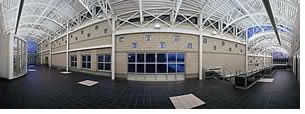 Commercial photographer Tom Watson believes this technology is “the
sharpest photographic technology ever deployed.” To get a quick
feel for the difference between large-format, high-end digital cameras
versus regular digital cameras, a high-end camera uses 144-megapixels,
whereas the standard point-and-shoot digital camera now on the market
uses 5-10 megapixels.
Commercial photographer Tom Watson believes this technology is “the
sharpest photographic technology ever deployed.” To get a quick
feel for the difference between large-format, high-end digital cameras
versus regular digital cameras, a high-end camera uses 144-megapixels,
whereas the standard point-and-shoot digital camera now on the market
uses 5-10 megapixels.
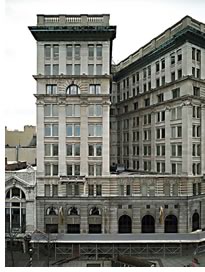 It’s in the details
It’s in the details
Watson believes large-format digital images, which contain more detail
than film, are indispensable for architects if they want wide panorama
shots of interiors and exteriors for their clients. “Architects
use the images to show a client the space of a design,” says
Watson. “Digital panoramas are a valuable tool for architects
to explain space. They’ll use it in meetings and presentations
and they can show the viewer in the room part of the picture, or scroll
around the picture and then show them the whole thing as if they were
turning their head to see the panorama.”
The detail of the images, as Watson explains, is also useful to architects surveying a building for repair work. “We can now image a whole building in one photo with a resolution that is so good that architects can now see a detailed four-foot-square section that has cracks and water leaks.”
Watson refers to this technique that he and his company utilizes as “masonry survey.” As architects use images to study a building’s existing conditions, Watson can scale the images to the finest detail. “We give them a high-contrast image file in which they survey the image and scale its measurements. They make the repair estimates for the mason using call-out images of the areas of the building that need repair. The images can sub for line drawings.”
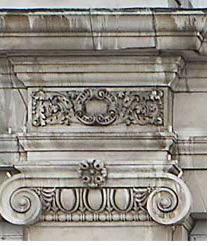 The method
The method
To do this, Watson loads the images into AutoCAD software. Without producing
any film or negatives, he uploads the photograph into the CAD software
and creates a half-tone raster-image data file representing a grid
of pixels, or points of color, on a computer monitor. The CAD program
translates the images’ pixels into inches, so the image is scalable
so the designer can zero-in on, for example, a tiny crack anywhere
on the building envelope.
As for the panorama shots, there are two methods: stitching and continuous panorama. Using computer software, stitching takes three photographs and joins them at each edge. Continuous panorama uses a step motor under a digital camera and is programmed by a computer to determine the lens size, exposure, and rotation, moving the camera pixel by pixel, to make a digital panorama. The advantage of high-end panoramas is that they can be used for the Web, blown up to billboard size, or reduced to an 8x10 print with a consistently high level of detail.
Large-format digital imaging with a wide angle lens also rectifies the parallax effect so that the image of the building appears flat rather than in perspective. “That image drives architects bonkers,” says Watson. “It’s not a usable photograph. But now we can get the whole building without line convergence. The sides of the building are not lost, and the building does not look as if it is falling over backwards.”
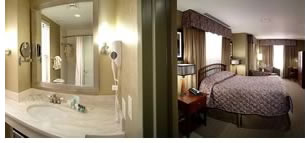 Architects like what they see
Architects like what they see
Ben Levine, AIA, of King & King, Architects, Manlius, N.Y., plans
to use digital images for a building conditions survey on the 10-story
M&T Bank Building in downtown Syracuse, N.Y. The 110-year-old building
is in need of repair. A lot of his repairs and investigations are going
to be made from scaffolding, but on a preliminary basis Levine and his
team are going to “blow up” the large digital photographs
of the building on their computer to see what they can tell about the
cladding on the building, then insert the pictures into drawings to produce
preliminary estimates based on what they see. “This is a building
built in the 1890s,” explains Levine. “For us to go and measure
it and to take two people in the field for a week and then draw it would
probably cost us one-and-a-half to two times what its costs us to do
it photographically, so it’s a big timesaver and money saver for
the owner.”
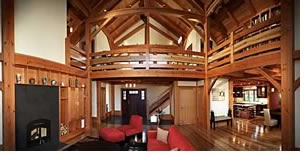 Panoramic digital photography is an asset to Holt Architects in Ithaca,
N.Y. Principal architect Robert J. O’Brien, AIA, is a strong advocate. “Large-format
digital portraits of our projects allow us to repurpose these photos
for a wide variety of uses,” O’Brien said. “We’re
able to generate everything from gallery-quality prints for award submissions,
to large-scale boards for presentations, to tiny JPGs for the Web site.
We love the level and quality of detail that we can get by zooming into
a file.”
Panoramic digital photography is an asset to Holt Architects in Ithaca,
N.Y. Principal architect Robert J. O’Brien, AIA, is a strong advocate. “Large-format
digital portraits of our projects allow us to repurpose these photos
for a wide variety of uses,” O’Brien said. “We’re
able to generate everything from gallery-quality prints for award submissions,
to large-scale boards for presentations, to tiny JPGs for the Web site.
We love the level and quality of detail that we can get by zooming into
a file.”
Steve Krause, AIA, principal architect for QPK Design in Syracuse, says the most important benefit for him of digital photography is the ability to get good panoramic photographs of interior spaces that are not expansive. “It’s historically been very difficult to get decent imagery of relatively small spaces,” says Krause. “We were limited to big atriums and large spaces that lent themselves to film-based photography. Digital photography can pan a space and get us very good-quality images of relatively small spaces. That was a huge development.”
Watson says each of the architects he has worked with has fostered a climate of experimentation and growth in large-format digital photography. Architects like O’Brien are pleased with the results. “Large-format digital images are valuable to architects since they can capture the full scope of spaces that would be impossible to capture with traditional photographic equipment.”
Copyright 2005 The American Institute of Architects.
All rights reserved. Home Page ![]()
![]()
 |
||
Photographs
copyright Tom Watson, Tom Watson Photography.
|
||